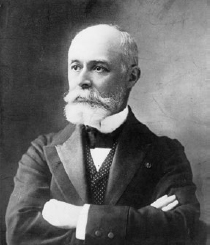1896
Radioactivity
Wilhelm Röntgen (1845–1923), Henri Becquerel (1852–1908), Pierre Curie (1859–1906), Marie Skłodowska Curie (1867–1934)
Late-nineteenth-century physics labs in Europe and America were quite literally abuzz with new discoveries related to electricity and magnetism. The newly created ability to generate and store large voltages and currents for use in a variety of experiments often led to surprises, such as the German physicist Wilhelm Röntgen’s 1895 study of high-voltage cathode ray tubes that generated a mysterious new form of radiation, which he dubbed X-rays.
The French physicist Henri Becquerel suspected that the ability of some natural materials to phosphoresce (glow in the dark) might be related to X-rays. He conducted a series of experiments in 1896 to determine if these materials emitted X-rays when exposed to sunlight, and accidentally discovered that one of the materials, uranium salts, spontaneously emitted radiation on its own. He had discovered radioactivity, something altogether different from X-rays.
Becquerel went on to collaborate with fellow French physicists Pierre Curie and Marie Skłodowska Curie, who were also interested in the strange and exotic behavior of this newly discovered spontaneous radiation. Marie Curie’s studies of uranium led her to the discovery of two new radioactive elements, polonium (named for her native Poland), and radium. In recognition of their fundamental discoveries, Becquerel and the Curies were awarded the 1903 Nobel Prize in Physics.

A 1918 photo of Henri Becquerel, discoverer of radioactivity.
Over the past century, radioactivity has been exploited as a natural “clock” because radioactive elements release energy and decay into other elements at a predictable rate. Radioactivity has been used to accurately determine the ages of the Earth, Moon, meteorites, and, by extension, the entire solar system and beyond, using the age and evolution of the Sun as a guide. Because of radioactivity and the pioneering work of scientists like Becquerel and the Curies, we now know, with astonishing precision, that the Earth is 4.54 billion years old, and that the solar system formed 4.567 billion years ago.
SEE ALSO Birth of the Sun (c. 4.6 Billion BCE), Earth (c. 4.5 Billion BCE), Birth of the Moon (c. 4.5 Billion BCE), Mapping the Cosmic Microwave Background (1992), Age of the Universe (2001).
Pierre and Marie Curie, at work studying radioactivity in their laboratory in Paris, sometime before 1907.
